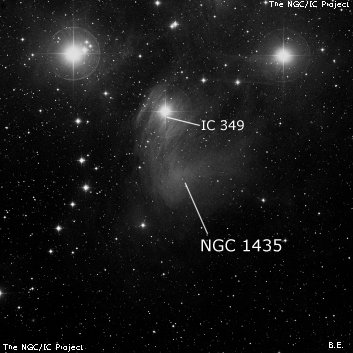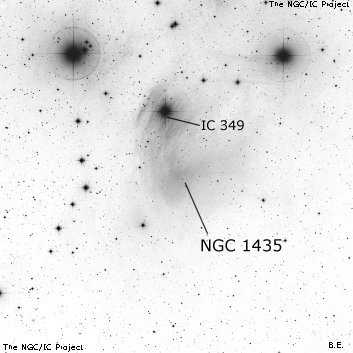NGC/IC Project Restoration Effort
(This is a very very beta version)
NGC1435


Basic Information
Location and Magnitude
Right Ascension: 3:46:10.0
Declination: +23:45:54
Constellation: TAU
Visual Magnitude:
Historic Information
Discoverer: Tempel
Year of discovery: 1859
Discovery aperture: 4.0
Observational
Summary description: vF, vL, dif (Merope)
Sub-type: RN
Corwin's Notes
=====
NGC 1435 is the part of the reflection nebula around Merope extending almost
directly south by 10 to 15 arcmin from the star. For some time, I had thought
that it and IC 349 (which see) are identical. However, reading Barnard's
careful observations of the Pleiades in AN 3018 (where he announces the
discovery of IC 349), it became clear that the IC object is actually a
brighter knot in the larger Merope nebula, and very close to the star itself.
Under normal conditions, Merope's light swamps the knot, so it is not
surprising that it was not found until the keen-eyed Barnard turned the Lick
36-inch refractor on it (though Pritchard claims an earlier image on a plate
taken at Cambridge in the late 1880's; see Herbig's article in AJ 111, 1241,
1996 for a complete history of IC 349).
NGC 1435 itself, however, is fairly easily seen on good nights with much
smaller telescopes. I've picked it out with a six-inch, and I suspect that
any good scope of four inches or more would give a view of it.
Steve's Notes
=====
NGC 1435
24" (12/28/16): at 124x (unfiltered): the huge Merope Nebula was easily visible, roughly spanning 20' in a wedge or triangular shape with mag 4.2 Merope close to the northeast vertex. The most well defined edge is clearly the eastern side as it extends N-S. The edge passes close to a string of 7 stars oriented NNW-SSE, including two mag 10 stars and nearly reaches mag 8.1 HD 23512, which is 20' SSE of Merope. Just before reaching this star the nebulosity clearly curves to the west and extends ~20' generally northwest, passing north of mag 9.0 HD 23326, though the border is slightly less defined. At this point the edges of the nebulosity can be traced back east or ENE back to Merope, though the edge here is the least defined. The surface brightness of the interior is irregular with some slightly brighter patches and weaker areas.
18" (1/26/11): at 73x (unfiltered), the Merope Nebula was immediately visible as a huge wedge-shape or comet-shaped glow with Merope near the focus on the northeast end and the nebula spreading out generally to the south and west. The most striking feature of the nebula is the well-defined and approximately eastern edge oriented N-S that heads south from Merope, passing through a 1' pair of mag 10/11 stars as well as a 1' pair of mag 10/12.5 star. The nebulosity can be traced a bit over 20' along this side. On the west side of Merope the border is more ill-defined but roughly heads southwest for ~20'. The southern border is also ill-defined but is roughly oriented NW to SE and nearly extends nearly as far as mag 9 HD 23326.
17.5" (3/2/02): at 100x, the Merope Nebula is the brightest of the reflection nebulae that encase the Pleiades. It appears as a moderately bright, very large, fan-shaped cone of light extended in a wedge SW to SE from Merope. The boundary of the nebulosity is straighter and better defined along the SE edge where it follows a string of mag 10-11 stars. The SW border is not as well defined but extends beyond a trio of mag 13 stars. The fan is broadest at its southern extremity which is roughly 15' from Merope.
16x80 (12/22/84): the Merope nebula was faint but definite in the 16x80 finder using a Deep Sky filter. Also, nebulosity surrounding other stars were confirmed with confidence at full aperture in the 13.1" at 62x.
8" (10/4/80): very large, faint, very elongated tear-drop shaped nebulosity extending SW away from Merope. Has a sharper edge along the eastern side. Best view using the Rich Field Adapter at 37x-50x.



